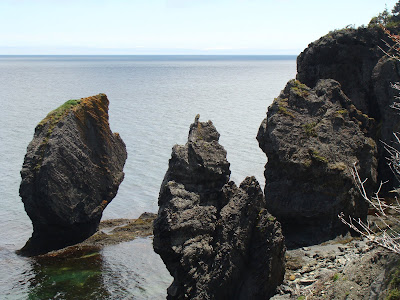
 This B&B is called "The Pond View", aptly named. We've had really good luck booking our B&B's as we go except for this time. After several calls to places in the area, we found this place. Not a historic one but it was pretty nice. It was recommended from another B&B. The owner's name was Sheila Tobin but no relation to Nadine. She rents it out usually as a summer vacation rental. It was great and we just had to drive a few minutes down the road to reach the trail head for our next hike on the East Coast Trail.
This B&B is called "The Pond View", aptly named. We've had really good luck booking our B&B's as we go except for this time. After several calls to places in the area, we found this place. Not a historic one but it was pretty nice. It was recommended from another B&B. The owner's name was Sheila Tobin but no relation to Nadine. She rents it out usually as a summer vacation rental. It was great and we just had to drive a few minutes down the road to reach the trail head for our next hike on the East Coast Trail.
We're in beautiful LaManche Provincial Park and had to visit Doctors Cove! We think that it was called "Doctors Cove" because of the risk of breaking an ankle while scrambling around on the rocks! Fortunately, according to the sign, there is a trail in just about any direction that you want to go.

 You feel like you're on another planet. Huge, black rock that seemed so porous. We climbed up and walked around an enjoyed the view from up here.
You feel like you're on another planet. Huge, black rock that seemed so porous. We climbed up and walked around an enjoyed the view from up here.

 These two pictures are for Martin's daughter Aline, who is studying geology. You can see the layer of quartz in these 500 million year old limestone rocks!
These two pictures are for Martin's daughter Aline, who is studying geology. You can see the layer of quartz in these 500 million year old limestone rocks!  We can see the La Manche bridge that leads to the old La Manche Village that was abandoned in 1966 after an enormous storm with either a storm surge or a tsunami (accounts vary) destroyed the village.
We can see the La Manche bridge that leads to the old La Manche Village that was abandoned in 1966 after an enormous storm with either a storm surge or a tsunami (accounts vary) destroyed the village.

The bridge was rebuilt in 1999 and officially opened in 2000. I like the last line by Thomas A.Clark reads: "There are things that we will never see, unless we walk to them". In Newfoundland one really has to get out and walk about this beautiful country to really appreciate how amazing it is.
 This picture was taken from the end of the bridge looking out to the ocean. It is such a beautiful cove it's hard to imagine how big this storm must have been to take out the whole community. It seems to be tucked away and protected.
This picture was taken from the end of the bridge looking out to the ocean. It is such a beautiful cove it's hard to imagine how big this storm must have been to take out the whole community. It seems to be tucked away and protected. A good view of the suspension LaManche Bridge that connects the East Coast Trail to both sides of the harbour.
A good view of the suspension LaManche Bridge that connects the East Coast Trail to both sides of the harbour.

 Another gorgeous brown waterfall from the one side of the bridge which flows under it and past the village out to the ocean. Such a beautiful spot where these people once lived....except for the black flies that were really bad in this area. I guess it couldn't be perfect!
Another gorgeous brown waterfall from the one side of the bridge which flows under it and past the village out to the ocean. Such a beautiful spot where these people once lived....except for the black flies that were really bad in this area. I guess it couldn't be perfect! Back down from the trail where we parked our car just a common picture you'll see often in coves and bays of Newfoundland. When we first arrived and parked there was a young man painting the inside of this boat. We drove down a little further from here and found a bakery and had some tea and freshly baked Partridge berry cake..mmmm good! Partridge berries and Bakeapple berries are indigenous to Newfoundland. It makes really good jam and we had it at every B&B. Next stop was Bay Bulls and our boat tour...check out the whales!
Back down from the trail where we parked our car just a common picture you'll see often in coves and bays of Newfoundland. When we first arrived and parked there was a young man painting the inside of this boat. We drove down a little further from here and found a bakery and had some tea and freshly baked Partridge berry cake..mmmm good! Partridge berries and Bakeapple berries are indigenous to Newfoundland. It makes really good jam and we had it at every B&B. Next stop was Bay Bulls and our boat tour...check out the whales!












































